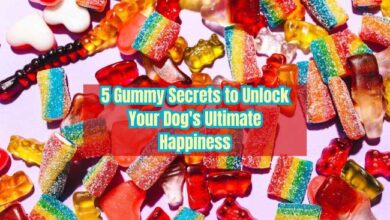
There are many foods that you can give to your dog. HHC gummies are also a superb option. Before giving any supplements to your pets, please ensure that you understand the implications of giving them to your pet.

Five pet food you can try If your dog feels cranky
1. Raw Eggs
Although we have spent a long time dreading raw eggs, did you realize that when eaten in their shells, eggs provide almost all of your dog’s nutritional needs? Selenium, vitamin B12, fatty acids, vitamin A, riboflavin, iron, and folate are among the nutrients that are abundant in eggs.
Although eggs should not be your dog’s primary source of nourishment, most dogs are okay with eating them sometimes. And keep in mind that frying an egg can lose many nutrients, so serve them fresh if you can.
If you cannot give your dog bone for whatever reason, crushing dried eggshells in grinders is a fantastic alternative that will still provide your dog with essential nutrients like calcium. Make sure you get the eggs from organic farmers if you decide to do this. To encourage consumers to purchase eggshells at the store, large commercial brands treat them with a chemical that makes them glossy. You do not want your dog to ingest such substances.
Recommended Dosage:
- When introducing any new cuisine, start with a modest dose and gradually increase it to a full one.
- Try quail eggs if you have a little dog.
- Add a raw egg to your dog’s feed once or twice weekly to replace a portion.
Top Brand Selections: The best options are local, organic, free-range, and organically fed. If you cannot find or afford particular eggs, buy as close to them as at your local grocery. For instance, Costco carries organic, free-range eggs.
2. Goat’s Milk
Due to the tiny size of its molecules, goat’s milk, sometimes known as “universal milk,” is the most easily digested milk available. Goat’s milk is an alternative that is often more hypoallergenic and more accepted than cow’s milk if your dog has problems with dairy products from animals.
Because probiotics are naturally present in raw goat’s milk, it offers all the advantages of probiotics in a highly absorbable form. Try goat’s milk if your dog has intestinal troubles. One other excellent technique to hydrate pets is with goat’s milk.
Recommended Dosage: When introducing any new cuisine, start with a modest dose and gradually move up to a full one.
- Pets up to 20 lbs: 1-2 ounces daily
- 20 to 40-pound pets: 2-4 ounces daily
- 40 to 60-pound pets: 4-6 ounces daily
- 6-8 ounces each day for a 60-80 lb pet.
- Over 80 lb pets: 8–10 ounces daily
Best Brands: Seek goat milk produced by organically bred animals, ideally raw and organic. In higher-priced pet food shops, you may find Primal Pet Foods’ raw goat’s milk in the freezer department. Their milk comes from goats who can roam freely without injecting antibiotics or hormones. They have added ginger, cinnamon, and turmeric to their goat’s milk.
3. Kefir
The “grain of life,” kefir, provides a wealth of health advantages. Due to their similar appearances, kefir and yogurt are often comparable. However, kefir is like yogurt. Probiotics and helpful yeasts, which help fend against harmful yeast and bacteria, are abundant in the fermented food kefir.
The carbs in your dog’s dry food might be as high as 70%. Because carbohydrates serve as the primary energy source for pathogenic yeast, they create havoc in the body. Yeast overgrowth may cause your dog’s odor, itching, hair loss, and recurrent ear infections. You should immediately add a probiotic if your pet has recently experienced additional stress (such as being kenneled) or has taken medicine, particularly antibiotics. Experts also recommend taking a pre/probiotic supplement.
The advantages of using kefir supplements are as follows: It has helpful vitamins and minerals and is antibacterial and antifungal, helping with candidiasis, IBD, and allergies. Traditional kefir is made from cow’s milk but may also originate from sheep or goat’s milk; it is simply difficult to locate. It is also available in dairy-free varieties made with almond or coconut milk, but they are a bit harder to obtain.
Suggested dosage: Start with a modest serving with any new dish and gradually increase the size to the recommended serving size.
- Pets up to 20 lbs: 1-2 ounces daily
- 20 to 40-pound pets: 2-4 ounces daily
- 40 to 60-pound pets: 4-6 ounces daily
- 6-8 ounces each day for a 60-80 lb pet.
- Over 80 lb pets: 8–10 ounces daily
Top Brand Selections: You can use many brands’ raw, organic kefir. It is created with natural, organic cow’s milk and produced humanely. It is in the freezer area of your neighborhood’s upscale pet food shop. Try to utilize organic sources that are organic, GMO-free, antibiotic-free, and hormone-free, as you would with any food.
4. Sardines
The amino acid taurine has recently become the topic of much discussion. Sardines are a great source of taurine, something many people try to add to their pets’ diets. Additionally, they are an excellent source of omega-3 fatty acids, which are crucial for optimum health. Because sardines are little, transient fish, many experts adore them. Because they do not consume bigger, older fishes that have had time to collect poisons in their bodies, they have little time to do so. They are hence “clean” fish in a sense.
Recommended Dosage: When introducing any new cuisine, start with a modest dose and gradually increase it to a full one. 2-3 times a week, consider substituting a few sardines for a component of your dog’s diet.
5. Pumpkin Puree
For a time now, pumpkin has enjoyed popularity as a dietary supplement, and with good cause. Because it contains a lot of soluble fiber, it is one of the most excellent strategies for controlling digestion. It helps build muscle in your dog’s feces if they are experiencing the runs.
Suggested dosage: Start with a modest serving with any new dish and gradually increase it to the recommended size. Add one tablespoon to your dog’s meal for every 10 pounds of body weight, or freeze in ice trays for a delicious treat.
Top Selections: The pumpkin you buy will probably be in a can. The pumpkin should be the only component. A pure pumpkin should be used, not a mix.
HHC Gummies
You can also try experimenting with HHC gummies. These products may be suitable for some pets. They can help them feel calm. If you proceed with these products, ensure that you stay within the suggested limits. Talking to your dog’s veterinarian about how to proceed is recommended for the dog’s safety.
Conclusion
You can feed them only some of these things at every meal. Feed the items you have at the site or alternate between them. A healthy diet requires variety throughout time. The pet food industry has previously told us the exact opposite, which is surprising.



